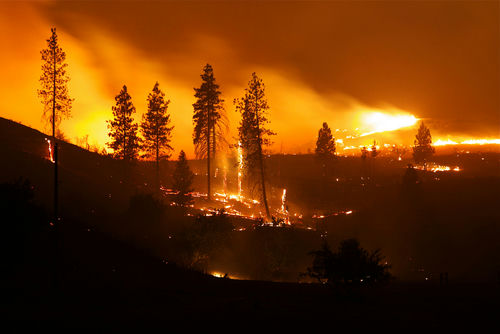Wildfires raging through Black Canyon of the Gunnison National Park have forced a complete evacuation—while federal agencies scramble, local families and businesses are left to wonder: who will be there for them after the smoke clears?
Federal Agencies Scramble, Local Communities Pay the Price
Once again, it’s the everyday Coloradans—families, ranchers, and small business owners—who are left holding the bag while bureaucrats in Washington, DC, issue press releases. Black Canyon of the Gunnison National Park, a genuine American natural wonder, has become the latest casualty of nature’s fury and the government’s chronic lack of preparation. On July 10, 2025, lightning sparked wildfires on both the North Rim and South Rim, sending flames tearing through parched, drought-stricken vegetation. The park sits in Montrose County, a region already suffering under extreme drought, and now, thanks to high winds and record temperatures, the South Rim Fire has exploded across 1,640 acres with zero containment in sight.
Federal and state agencies rushed in with their usual flurry of command centers and coordinated response jargon, as if that’s supposed to comfort the families and business owners now staring down the barrel of lost livelihoods. The National Park Service, Colorado Division of Fire Prevention and Control, and the Montrose County Sheriff’s Office all joined the fray. The result? Total evacuation. Every visitor and staff member has been forced out, roads are closed, and tourism—the backbone of Montrose’s summer economy—has ground to a halt. The only thing moving fast is the fire itself, fueled by conditions everyone saw coming months ago as the drought map turned redder and redder. Meanwhile, officials urge the public not to call 911 for updates, as if the lack of information somehow brings peace of mind to worried residents and business owners left in limbo.
Economic Fallout and Government Priorities
The closure of Black Canyon of the Gunnison National Park is about more than just lost scenery. It’s a direct hit to local businesses, outfitters, and families counting on summer tourism to pay their bills. When government agencies warn that “fire activity is expected to increase” and highways remain blocked, it’s small towns and rural America that bear the brunt. Will there be swift emergency aid for business owners? Don’t bet on it. Recent years have made it painfully clear that when disaster strikes, taxpayer dollars seem to flow everywhere but to the citizens who need them most. The bureaucracy is quick to protect its own assets—firefighters hustled to save the park visitor center with vegetation clearance and fire-resistant wraps—but who is wrapping up the financial damage for the mom-and-pop diners, guides, and motels whose livelihoods just went up in smoke?
⚠️ PARK ALERT ⚠️
Due to the advancing White Sage Fire, located approximately 15 miles southeast of Fredonia, all visitors on the North Rim of Grand Canyon National Park are required to evacuate immediately. The fire is moving toward Jacob Lake, AZ, which is currently under… pic.twitter.com/NXruchFAFm
— Grand Canyon NPS (@GrandCanyonNPS) July 11, 2025
All the while, the political class obsesses over everything but the basics of protecting Americans and their land. Washington can always find billions for pork-barrel pet projects or to subsidize the latest “woke” initiative, but when it comes to basic fire preparedness and rural infrastructure, suddenly the coffers run dry. Local taxpayers, meanwhile, are treated like afterthoughts in their own communities, left to clean up both the literal and figurative ashes on their own dime.
The Rising Cost of Wildfires and the Real Climate of Responsibility
The experts will tell you the obvious: Drought, high winds, and dry brush are the perfect recipe for disaster. But while fire officials and academics pontificate on climate conditions, the fact remains that year after year, Western states are left with the same thin promises and reactive responses. Wildfire season has become a grim ritual, and the pattern is as clear as the smoke plumes on the horizon—government reacts, communities absorb the loss, and little changes.
🚨DEBRIEFING: TIMELINES PATTERNS & FIRE
🔥 Something’s burning beneath the surface.
Both Grand Canyon’s North Rim and Black Canyon of the Gunnison evacuated due to fast-moving wildfires.
Zero containment.
Triggered by “lightning.”
Multiple rim fires igniting within hours.
Two… pic.twitter.com/hzAfVx4agx— TheDebriefing17 (@TheDebriefing17) July 11, 2025
Local residents and business owners, the true stakeholders, are rarely prioritized in the decision-making process. Instead, the focus shifts to “structure protection” and “resource allocation,” bureaucratic buzzwords that sound good in press conferences but do little to address the root issues. Calls for “improved public communication” and “proactive evacuation planning” ring hollow when the primary concern is simply getting people out and shutting everything down, not restoring or protecting the economic heartbeat of these rural communities. The reality is that ecological damage, lost revenue, and long-term infrastructure costs will linger long after the TV cameras and press briefings move on. The cycle of neglect continues, with ordinary Americans footing the bill for the failures of those in charge.

